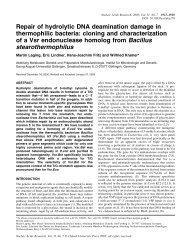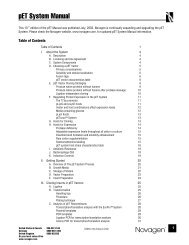DNA Mismatch Repair: Functions and Mechanisms
DNA Mismatch Repair: Functions and Mechanisms
DNA Mismatch Repair: Functions and Mechanisms
Create successful ePaper yourself
Turn your PDF publications into a flip-book with our unique Google optimized e-Paper software.
<strong>DNA</strong> <strong>Mismatch</strong> <strong>Repair</strong> Chemical Reviews, 2006, Vol. 106, No. 2 309<br />
Figure 3. RPA regulation of mismatch-provoked 5′ to 3′ excision. As described in the text, MutSR confers a high degree of processivity<br />
on ExoI presumably via formation of a molecular complex between the two proteins (left). RPA reduces the processivity of this complex<br />
to about 250 nucleotides (right). An RPA-filled gap is an extremely poor substrate for ExoI reloading, but MutSR can promote reloading<br />
if the <strong>DNA</strong> contains a mismatched base pair. Hence, in the presence of RPA, excision is dramatically attenuated upon mismatch removal<br />
because MutSR can no longer assist in this manner. This effect is potentiated by MutSR <strong>and</strong> MutLR, which act together to suppress ExoI<br />
activity on <strong>DNA</strong> that lacks a mismatch, leading to effective termination of excision.<br />
provided that the <strong>DNA</strong> contains a mismatched base pair.<br />
Hence, excision is dramatically attenuated upon mismatch<br />
removal because MutSR can no longer assist in this manner.<br />
This effect is potentiated by MutSR <strong>and</strong> MutLR, which act<br />
together to suppress ExoI hydrolysis on <strong>DNA</strong> that lacks a<br />
mismatched base pair, leading to effective termination of<br />
excision. 216 Interestingly, this simple mechanism provides a<br />
potential explanation for one of the most puzzling questions<br />
in mismatch repair. In both the bacterial <strong>and</strong> human systems,<br />
excision terminates at a number of sites centered about 100<br />
nucleotides beyond the original location of the mispair. The<br />
mechanism of this four protein purified system suggests that<br />
termination in this manner may be a simple consequence of<br />
the distance separating the nick <strong>and</strong> the mispair coupled with<br />
the degree of processivity of the hydrolytic system, that is,<br />
the number of times the excision system must be reloaded<br />
to effect mismatch removal.<br />
The 5′ to 3′ directionality of this four protein system can<br />
be regarded as a default polarity because hydrolysis always<br />
proceeds 5′ to 3′ from the str<strong>and</strong> break without regard to<br />
nick location 5′ or 3′ to the mismatch. Thus, when the nick<br />
that directs excision is 5′ to the mispair, hydrolysis proceeds<br />
5′ to 3′ toward the mismatch, terminating upon mismatch<br />
removal. However, the four protein system also supports<br />
mismatch-provoked excision on a 3′-heteroduplex, <strong>and</strong> in<br />
this case, hydrolysis also proceeds with 5′ to 3′ polarity,<br />
which is incorrect directionality for mismatch removal. 198,222<br />
This observation led to the finding that supplementation of<br />
MutSR, MutLR, ExoI, <strong>and</strong> RPA with PCNA <strong>and</strong> RFC (the<br />
enzyme that loads the PCNA clamp onto the helix) 225 yields<br />
a system that supports bidirectional excision. 222 When the<br />
nick that directs the reaction is located 5′ to the mismatch,<br />
hydrolysis in this six-component system proceeds 5′ to 3′<br />
as it does in the default pathway. However, when the nick<br />
is located 3′ to the mispair, 5′ to 3′ hydrolysis by ExoI is<br />
suppressed, <strong>and</strong> excision proceeds with apparent 3′ to 5′<br />
polarity, resulting in mismatch removal (Figure 4). The<br />
apparent 3′ to 5′ polarity of excision in this system assumes<br />
that the hydrolytic events leading to mismatch removal<br />
Figure 4. A purified human system that supports bidirectional<br />
excision. A six-component system comprised of MutSR, MutLR,<br />
ExoI, RPA, RFC, <strong>and</strong> PCNA supports mismatch-provoked excision<br />
directed by a str<strong>and</strong> break located either 3′ or 5′ to the mismatch.<br />
Both 3′- <strong>and</strong> 5′-directed excision reactions depend on integrity of<br />
the ExoI active site. The simplest explanation for this finding is<br />
that ExoI mediates both 3′- <strong>and</strong> 5′-directed excision; this point has<br />
not been established. Green arrows indicate that the reaction is<br />
dependent on signaling between the two <strong>DNA</strong> sites. Reprinted with<br />
permission from ref 222. Copyright 2004 Elsevier, Inc.<br />
initiate at the str<strong>and</strong> break that directs the reaction, but this<br />
point has not been established. 222 Nevertheless, this sixcomponent<br />
system displays the key element of bidirectional<br />
excision that has been observed in nuclear extracts, namely,<br />
activation of differential excision events in response to 3′-<br />
or 5′-heteroduplex orientation.<br />
3′-Directed excision in the six-component system requires<br />
MutSR, MutLR, ExoI, PCNA, RFC, <strong>and</strong> ATP with RPA<br />
stimulating the reaction. The ExoI requirement for both 5′-<br />
<strong>and</strong> 3′-directed excision in the reconstituted bidirectional<br />
system is similar to the bidirectional requirement for the<br />
protein in nuclear extracts. 198,199 Although the role of the 5′<br />
to 3′ exonuclease in 3′-directed excision is not clear, analysis<br />
of an active site mutant has demonstrated a requirement for<br />
the ExoI catalytic center in both 5′- <strong>and</strong> 3′-directed reactions.<br />
222 Several possible explanations could account for this<br />
finding. ExoI could play a structural role in the assembly of<br />
a multiprotein repair complex required for activation of 3′-<br />
directed excision by an as yet unidentified activity associated<br />
with another repair protein; 194 however this possibility is<br />
somewhat difficult to reconcile with the ExoI active site<br />
requirement in 3′-directed excision. It has also been suggested




